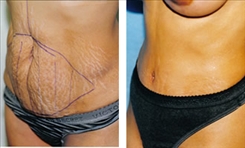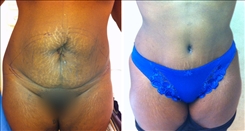Umbilicoplasty Surgery
Posted On: January 10, 2013 Author: The Office of Dr. Stuart Linder Posted In: Body Sculpting, Tummy Tuck
Patients presents for umbilicoplasty reconstruction most often concurrent with full tummy tuck procedures. The umbilicus is an area that can be a focal point on a woman’s abdomen due to gaining of weight, loss of weight as well as pregnancy. The umbilicus can change shape, form and also can go from inverted to externally protruded or vice-versa. During a full abdominoplasty, dissection is carried well up above the umbilicus up to the subxiphoid process. The umbilicus is maintained at stock to the fascia of the rectus muscle; however, a new hole will be made and the umbilicus will be sutured into its new position. There are limitations as to how much change can be performed on the umbilicus in order to prevent devascularization. Skin around the umbilicus can be removed; however, it should be done somewhat conservatively in order to prevent a disproportionately large umbilicus. Also, the shape of the umbilicus can be changed from round to oval, pear-shaped in either the vertical or in the transverse manner. Creation of an umbilicus after weight loss or reconstruction can require excision of skin with excision of portions of the umbilicus in order to smooth it out, reduce visible deformities around it. Examples of an umbilicoplasty are shown below. Note the skin has lost elasticity in that the umbilicus sometimes can be hidden by the overhang of skin from the upper abdominal area. Problems with umbilicoplasty surgery can include keloid scarring and hypertrophic scarring which can lead to complete constriction and contraction of the umbilicus which may lead to a hole to close up. This can be problematic as to infections and malodorous discharge. As a result, umbilicus reconstruction to maintain the external skin is approximately 1.5 cm vertically by 1.25 cm transversely, according to Dr. Linder.
 Umbilicoplasty reconstruction requires significant skill. Again, there are limitations associated with the final result as you cannot always correct the specific aesthetic appearance of the umbilicus without devascularization. Only Board Certified Plastic and Reconstructive Surgeons should perform this difficult operation.
Umbilicoplasty reconstruction requires significant skill. Again, there are limitations associated with the final result as you cannot always correct the specific aesthetic appearance of the umbilicus without devascularization. Only Board Certified Plastic and Reconstructive Surgeons should perform this difficult operation.
